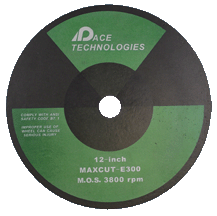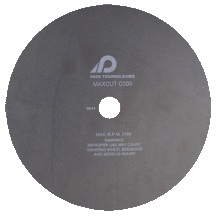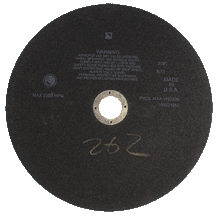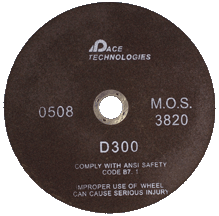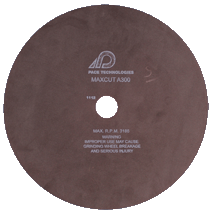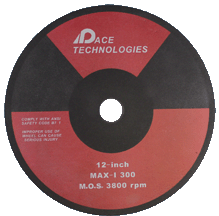PACE Metallographic Products
Technical Info Online Ordering
Abrasive Cutting Technical Overview
Introduction
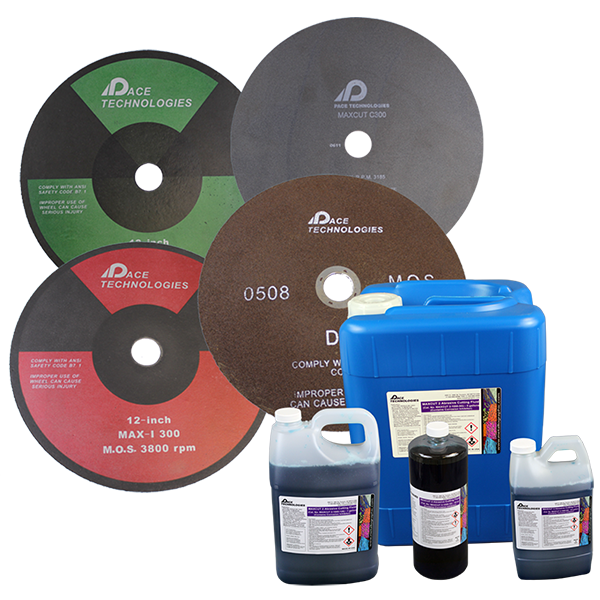
The first step in preparing a specimen for metallographic or microstructural analysis is to locate the area of interest. Sectioning or cutting is the most common technique for obtaining this area. Proper sectioning has the following characteristics:
Desirable Effects:
- Flat and cut close to the area of interest
- Minimal microstructural damage
Undesirable Effects:
- Smeared (plastically deformed) metal
- Heat affected zones (burning during cutting)
- Excessive subsurface damage (cracking in ceramics)
- Damage to secondary phases (e.g., graphite flakes, nodules, or grain pull-out)
The goal of any cutting operation is to maximize the desirable effects, while minimizing the undesirable effects.
Sectioning can be categorized as either abrasive cutting and precision wafer cutting. Abrasive cutting is generally used for metal specimens and is accomplished with silicon carbide or alumina abrasives in either a resin or resin-rubber bond. Proper blade selection is required to minimize burning and heat generation during cutting, which degrades both the specimen surface as well as the abrasive blades cutting efficiency. Wafer cutting is achieved with very thin precision blades. The most common wafering blades are rim-pressed abrasive blades, in which the abrasive is located along the edge or rim of the blade. Precision wafering blades most commonly use diamond abrasives, however cubic boron nitride (CBN) is also used for cutting samples that react to dull diamond (e.g. high carbon, heat treated steels cut more effectively with CBN as compared to diamond). Wafer cutting is especially useful for cutting electronic materials, ceramics and minerals, bone, composites and even some metallic materials.

Abrasive Blade Selection Guidelines
Selecting the correct abrasive blade depends on the design of the cut-off machine and, to a large extent, operator preference. Abrasive blades are generally characterized by their abrasive type, bond type, and hardness. Determining the correct blade depends on the material or metal hardness and whether it is ferrous or nonferrous. In practice, it often comes down to odor and blade life. Resin/rubber blades smell more because the rubber will burn slightly during cutting; however, resin/rubber blades do not wear as fast and therefore last longer. On the other hand, resin blades are more versatile and do not produce a burnt rubber odor, but they do break down faster. Resin blades also provide a modestly better cut because the cutting abrasive is continually renewed, producing a cleaner cut.
Note that the traditional "older" technology for producing abrasive blades resulted in very specialized resin/rubber blades. Finding the proper resin/rubber hardness, abrasive size, and blade thickness to match the sample properties and the cutting machine parameters required a lot of testing and experimentation. In the past, resin/rubber blades were more popular in the US market. However, in recent years, as resins have improved, there has been a trend towards resin bonded abrasives. Conversely, resin bonded blades have typically been more widely used in the European and Asian markets for quite some time.
Summary:- Resin bonded blades - less smell, higher wear, less sample burning, more versatile
- Resin-rubber bonded blades - longer life, burnt rubber smell, more likely to burn the sample, more difficult to find the correct blade

Abrasive Blade Thickness
| Blade Thickness (inches) | 10-inch | 12-inch | 14-inch | 16-inch |
|---|---|---|---|---|
| MAX-A | 0.039 | 0.055 | 0.063 | 0.090 |
| MAX-C | 0.059 | 0.078 | 0.078 | 0.100 |
| MAX-D | 0.059 | 0.078 | 0.078 | 0.100 |
| MAX-E | 0.059 | 0.078 | 0.078 | 0.100 |
| MAX-I | 0.059 | 0.078 | 0.078 | 0.100 |
| MAX-VHS | 0.075 | 0.078 | 0.098 | 0.100 |
| DMAX | 0.059 | 0.060 | 0.060 | 0.075 |
Abrasive Blade Maximum Operating Speed (MOS)
| Maximum Speed (rpm) | 10-inch | 12-inch | 14-inch | 16-inch |
|---|---|---|---|---|
| MAX-A | 3820 | 3185 | 2730 | 2860 |
| MAX-C | 3440 | 3185 | 3460 | 2390 |
| MAX-D | 4585 | 3820 | 3275 | 3800 |
| MAX-E | 4500 | 3800 | 3200 | 3800 |
| MAX-I | 4500 | 3800 | 3200 | 3800 |
| MAX-VHS | 3055 | 2500 | 2220 | 1925 |
| DMAX | 6100 | 5000 | 4350 | 3800 |
Abrasive Cutting Process Description
Abrasive sectioning has primarily been used for sectioning ductile materials. Examples include metals, plastics, polymer matrix composites, metal matrix composites, plastics, and rubbers. The proper selection of an abrasive blade requires an understanding of the relationship between the abrasive particle, abrasive bonding, and the specimen properties.
Abrasive Type
Today's high-performance abrasive blades use alumina or silicon carbide abrasives. Alumina is a moderately hard and relatively tough abrasive, making it ideal for cutting ferrous metals. Silicon carbide is a very hard abrasive that fractures and cleaves easily, making it a self-sharpening abrasive more commonly used for cutting nonferrous metals.
Bonding Material
The hardness and wear characteristics of the sample determine which resin system is best suited for abrasive cutting. In general, the optimum bonding material breaks down at the same rate as the abrasive dulls, exposing new abrasives for the most efficient and effective cutting operation.
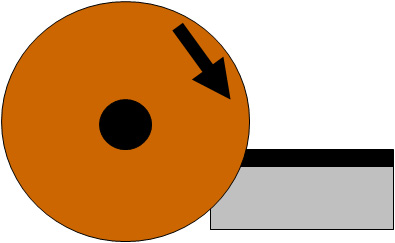
Abrasive Cutter Speed
Variable speed saws allow the user to better control the abrasive cutting process by matching the cutting speed with the hardness of the blade to minimize damage while maximizing the cutting speed. Typically, softer metals are cut at slower speeds to reduce the cutting burr or smearing of the metal. Harder samples are cut at medium to high speeds to break down the wheel bond and expose new, sharp abrasives. Note that for hardened steels, the recommended cutting speed for the MAX-VHS blades is approximately 50% of the maximum MOS to prevent overheating and burning at the specimen surface.

Recommended Abrasive Cutting Procedures
- Select the appropriate abrasive blade.
- Secure specimen. Improper clamping may result in blade and/or specimen damage.
- Check coolant level and replace when low or excessively dirty. Note abrasive blades break down during cutting and thus produce a significant amount of debris.
- Adjust the abrasive cutter speed to optimize the cutting process. Typically softer metals are cut at slower speeds to reduce the cutting burr or smearing of the metal. Harder samples are cut at medium to high speeds in order to break down the wheel bond in order to expose new / sharp abrasives.
- Allow the abrasive blade to reach its operating speed before beginning the cut.
- A steady force or light pulsing action will produce the best cuts and minimize blade wear characteristics, as well as maintain sample integrity (no burning).
- When sectioning materials with coatings, orient the specimen so that the blade is cutting into the coating and exiting out of the base material, thereby keeping the coating in compression.

Cutting Fluids
Lubrication and swarf removal during abrasive cutting and diamond wafer cutting are required in order to minimize damage to the specimen. For some older abrasive cutters, the proper cutting fluid can also have the added benefit of coating cast iron bases and the fixtures in order to reduce or eliminate corrosion.
TIP: Most abrasive cutters have a hood, which can produce a corrosive humidity chamber when not in use. In order to reduce these corrosive effects, keep the hood open when not in use.
Abrasive Cutting Fluid - The ideal cutting fluid for abrasive cutting is one that removes the cutting swarf and degraded abrasive blade material. It should have a relatively high flash point because of the sparks produced during abrasive sectioning.
Abrasive Sectioning Troubleshooting
| Symptom | Cause | Action |
|---|---|---|
| Chipped or broken blade | -Secure sample properly- -Reduce cutting force |
-Secure sample properly -Reduce cutting force |
| Bluish burnt color on specimen | -Incorrect cutting fluid -Improper blade or excessive force |
-Use proper cutting fluid -Consult applications guideline or use a blade with a softer resin |

Abrasive Blade Product Descriptions
Abrasive Blades (32 mm / 1.25-inch arbor) (Qty 10 per package)| Description | 10-inch | 12-inch | 14-inch | 16-inch |
|---|---|---|---|---|
| Soft non-ferrous materials (aluminum, brass, zinc, etc.) | MAX-E250 | MAX-E300 | MAX-E350 | MAX-E400 |
| Hard non-ferrous materials (titanium, zirconium, etc.) | MAX-C250 | MAX-C300 | MAX-C350 | MAX-C400 |
| Soft steels | MAX-E250 | MAX-E300 | MAX-E350 | MAX-E400 |
| Hard and case hardened steels | MAX-VHS250 | MAX-VHS300 | MAX-VHS350 | MAX-VHS400 |
| General steels and ferrous metals | MAX-D250T | MAX-D300 | MAX-D350 | MAX-D400 |
| Universal Thin Blade | MAX-A250 | MAX-A300 | MAX-A350 | MAX-A400 |
| Industrial general purpose thin blade | MAX-I250 | MAX-I300 | MAX-I350 | MAX-I400 |

